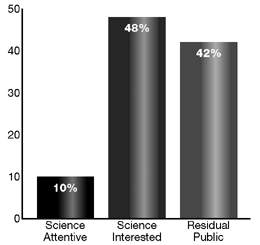
|
| Volume 51, Number 4, Fall, 2002 |
|
Sidebar . . . The Science-Attentive PublicA long-standing research effort with major implications for science communicators is the NSFs annual Science Indicators survey of the publics interest in and knowledge of science and technology. Based on these surveys, public science audiences are classified into three groups:
While many science communicators may believe that they are targeting their messages to the general public, they are in fact probably communicating with the science attentive. For example, in the 2001 NSF survey, about 10 percent of respondents
met the criteria for being science attentive, a drop of four percent
since 1997. Forty-eight percent were classified as science interested,
while 42 percent But take heart. A 10-percent science-attentive public still represents 20 million people. Moreover, communication with this audience has the effect of spreading the message more broadly since science attentives tend to be more politically active than average, have higher than average levels of education and income, and have a high level of crosstalk with other audiences. |
 were
classified as residual.
were
classified as residual.